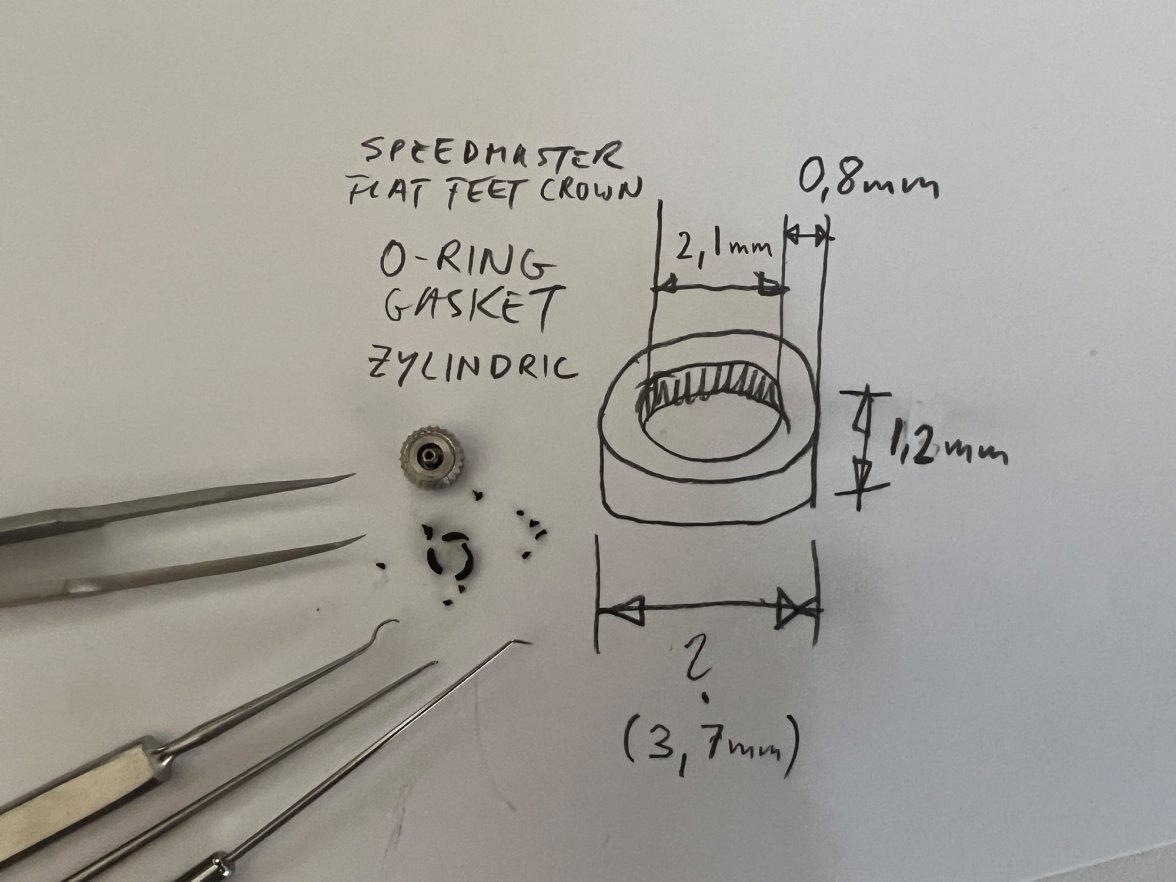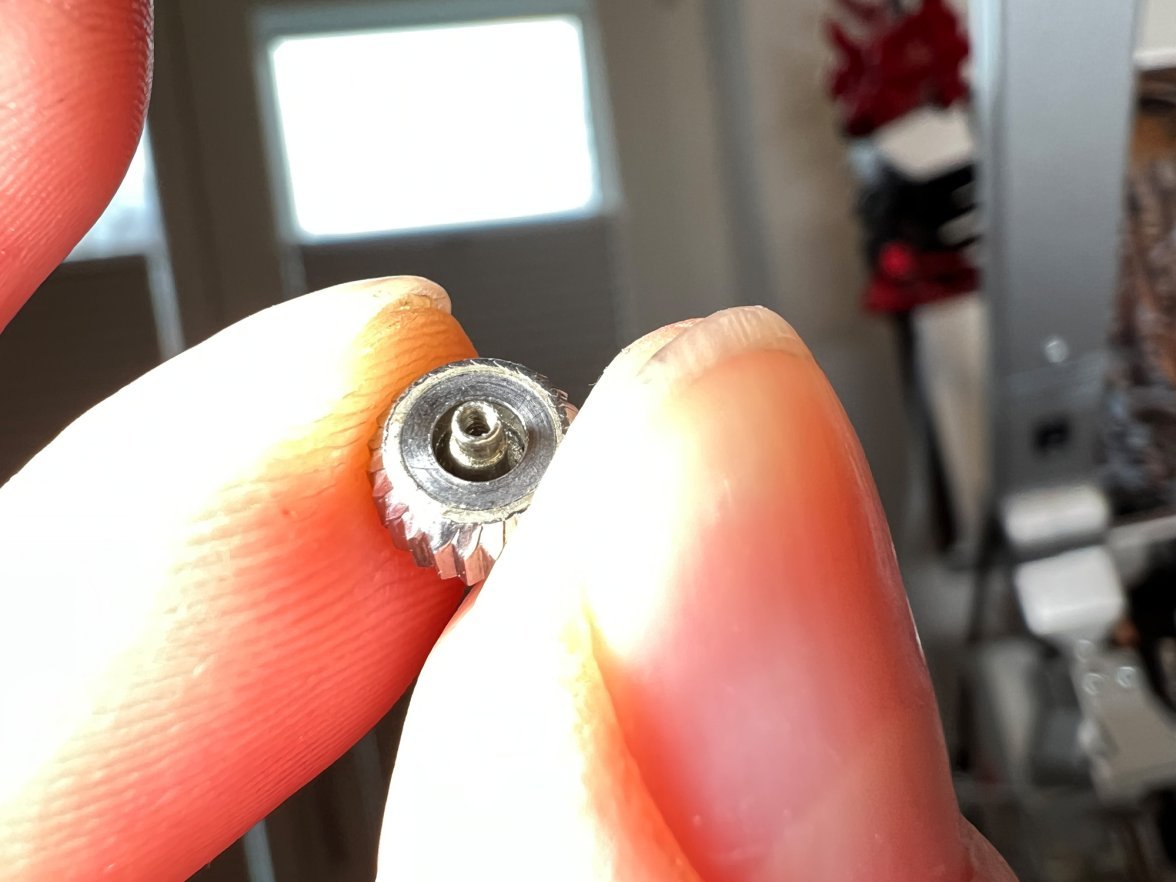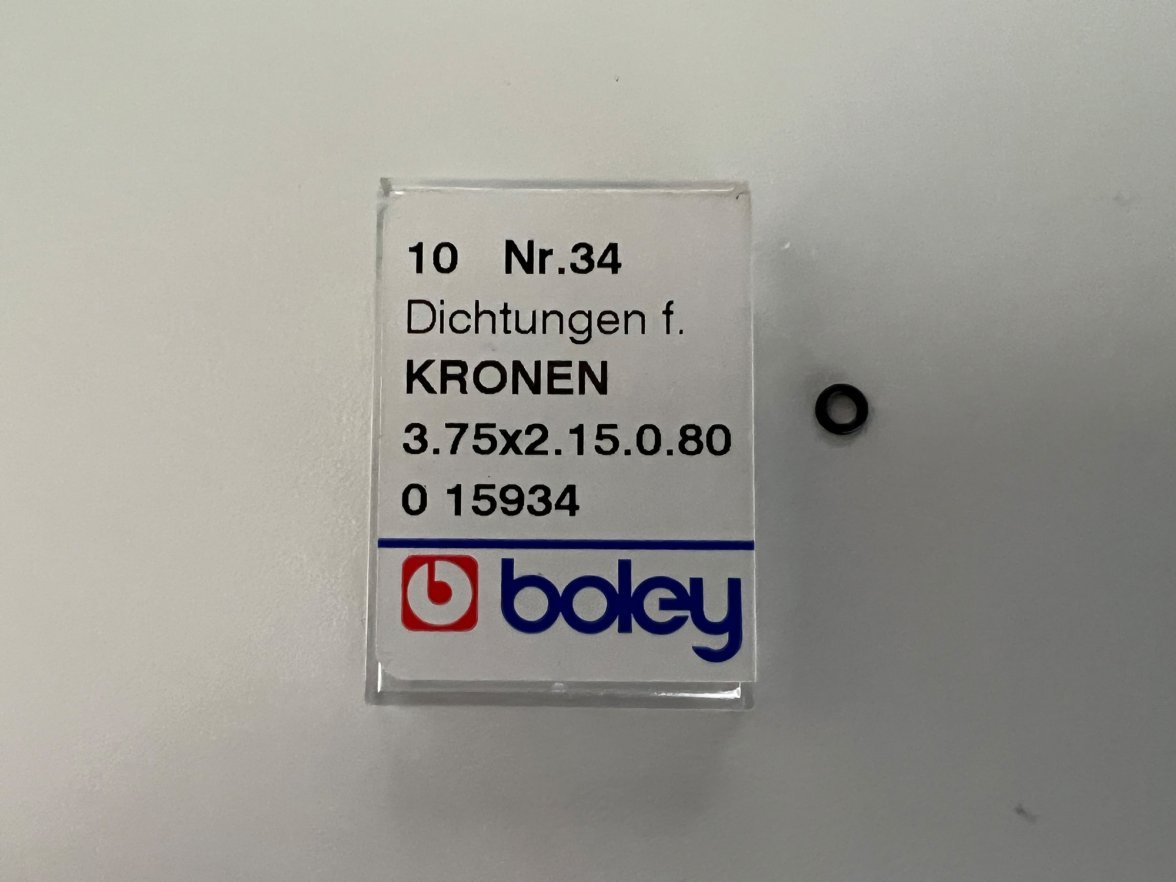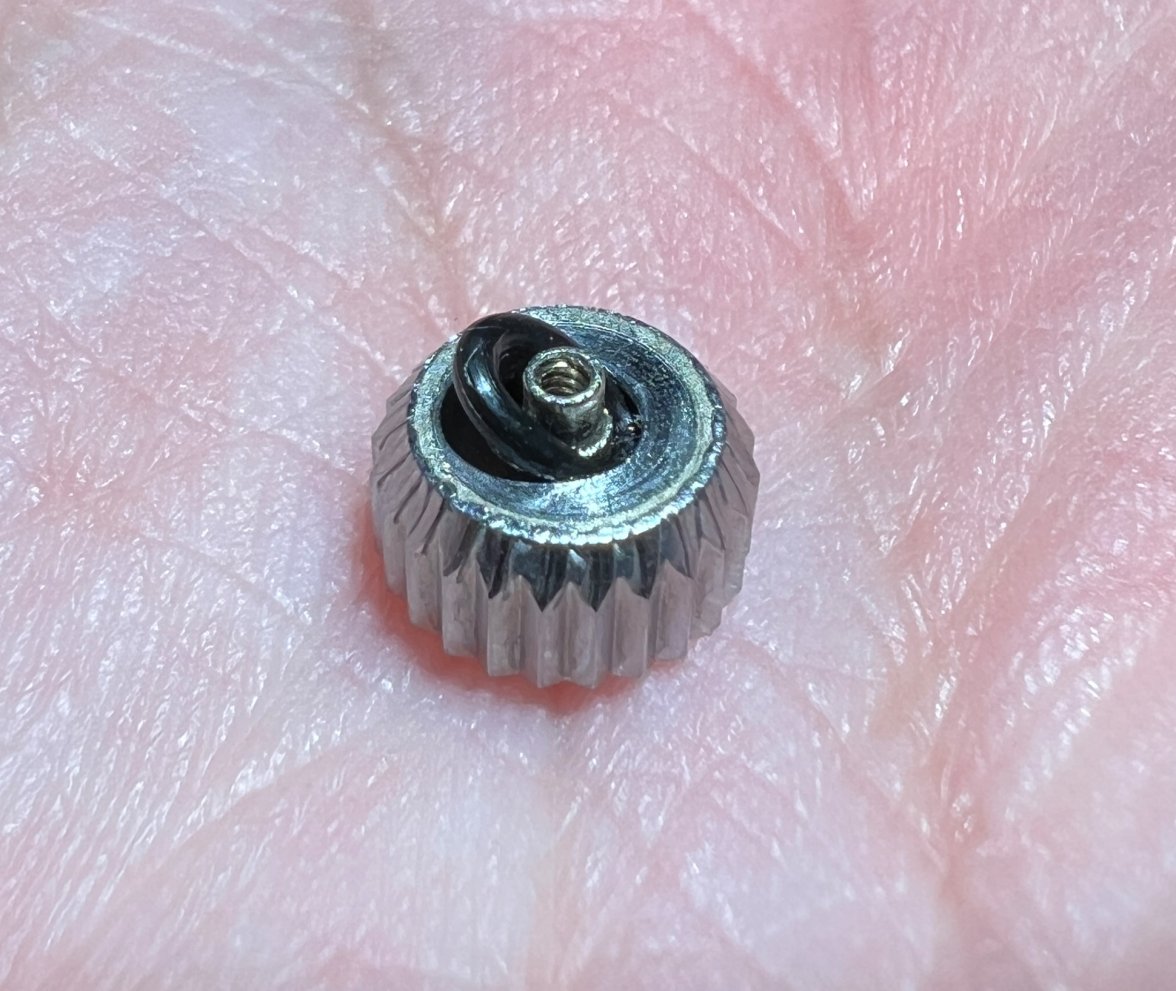Remove gasket from a Speedmaster "Narrow Flat Feet" crown
sirtaifun
·you are correct that these gaskets are not designed to be replaced, instead the entire crown is to be replaced.
Most watchmakers wont do because its to much effort compared to that what they can bill you for that work.
In olden times that was a standard.
Archer
··Omega Qualified WatchmakerAs to speak for my "personel" watchmaker this is some kind of routine operation for him on vintage crowns.
Most watchmakers wont do because its to much effort compared to that what they can bill you for that work.
In olden times that was a standard.
In "olden times" no one cared about the crown being flat footed or whatever - they just wanted a crown that worked, so they were routinely replaced.
If your watchmaker is willing to charge less than what the task takes him to do in terms of labour, then he may be a great watchmaker, but a so-so businessperson. I'm sure many people would pay handsomely to have their vintage crowns refurbished, so he's leaving good money on the table if he's not charging appropriately for his work.
For me personally, it's not about what I can charge, but what I'm willing to put a warranty on.
tritto
·Good work. What are those picks in your photos @perlunk? Dental picks?
I've decided to have a crack at the crown on one of my Seikos (a one button chrono circa 1967). The gasket is so hard I can barely turn the crown. I have sprayed it with WD40 and will leave it in a ziplock bag for a week to see what that does to the rubber before I start on extracting it.
I've decided to have a crack at the crown on one of my Seikos (a one button chrono circa 1967). The gasket is so hard I can barely turn the crown. I have sprayed it with WD40 and will leave it in a ziplock bag for a week to see what that does to the rubber before I start on extracting it.
perlunk
·Good work. What are those picks in your photos @perlunk? Dental picks?
I've decided to have a crack at the crown on one of my Seikos (a one button chrono circa 1967). The gasket is so hard I can barely turn the crown. I have sprayed it with WD40 and will leave it in a ziplock bag for a week to see what that does to the rubber before I start on extracting it.
I have tools intended for laboratory and surgical use:
https://www.finescience.de
Particularly:
https://www.finescience.de/de-DE/Products/Probes-Hooks/Probes/Bonn-Micro-Probes/10031-13
https://www.finescience.de/de-DE/Pr...s/Dumont-Forceps/Dumont-5-45-Forceps/11251-35
https://www.finescience.de/de-DE/Products/Probes-Hooks/Hooks/Micro-Hooks/10061-12
https://www.finescience.de/de-DE/Products/Probes-Hooks/Probes/Probes/10140-03
sirtaifun
·In "olden times" no one cared about the crown being flat footed or whatever - they just wanted a crown that worked, so they were routinely replaced.
If your watchmaker is willing to charge less than what the task takes him to do in terms of labour, then he may be a great watchmaker, but a so-so businessperson. I'm sure many people would pay handsomely to have their vintage crowns refurbished, so he's leaving good money on the table if he's not charging appropriately for his work.
For me personally, it's not about what I can charge, but what I'm willing to put a warranty on.
And often it was not so it was restored as it is very often nowadays in eastern part of europe as for what I hear from watch collectors of that area.
And I never mention that it doesn`t cost a fortune to hold on your old crown at "my" watchmaker 😁
Sure it cost less to have a working new crown but very often the vintage branded ones are not available anymore.
Archer
··Omega Qualified WatchmakerThey where replaced if there was a fitting spare part at hand.
And often it was not so it was restored as it is very often nowadays in eastern part of europe as for what I hear from watch collectors of that area.
I can't speak for Eastern Europe, but in the Western world, parts were generally readily available in the past. Not letting people buy parts is a fairly new thing with watch companies.
And I never mention that it doesn`t cost a fortune to hold on your old crown at "my" watchmaker 😁
Sure it cost less to have a working new crown but very often the vintage branded ones are not available anymore.
Please note the very first word...
If your watchmaker is willing to charge less
tinkercompanies
·- Try using a gasket removal tool: Some specialized tools are available for removing old gaskets from crowns. These tools have a blade that you can slide under the gasket and gradually lift it out. You may be able to find one of these tools online or at a watchmaking supply store.
- Use heat: Gently heating the crown with a hair dryer or heat gun can help soften the gasket and make it easier to remove. Be careful not to overheat the crown or apply too much heat for too long, as this could damage the crown.
- Use a chemical solvent: You could try soaking the crown in a solvent that can dissolve the gasket, such as acetone or isopropyl alcohol. However, be careful not to use a solvent that could damage the crown material or any internal parts. You may also need to soak the crown for a while to loosen the gasket.
- Seek professional help: If you are not confident in removing the old gasket yourself, or if you do not have the right tools or materials, you may want to consider taking the crown to a professional watchmaker or jeweler for servicing. They will have the expertise and equipment to safely remove the old gasket and replace it with a new one.
tritto
·Well I've done my crown. I sprayed some wd40 into the crown and put it in a ziplock bag for five days. I dug out the gasket yesterday with a combination of a sewing pin, sharpened toothpicks, and finally an old oiler once the heavy work was done. The gasket came out in small pieces and I'm not able to be entirely sure if the WD40 contributed, except that this gasket broke up a lot easier than the rock hard Bulova Accutron 666 gasket that I did last time. I had to chip away at that one for hours.
Once I was happy that the crown was clear and clean I squeezed in a new gasket (Seiko 6309-7040 diver gasket was a very snug fit). Some silicone might have helped that process, but I can't find my jar of Seiko silicone grease
And since no thread is complete without photos, here is the finished product.
Once I was happy that the crown was clear and clean I squeezed in a new gasket (Seiko 6309-7040 diver gasket was a very snug fit). Some silicone might have helped that process, but I can't find my jar of Seiko silicone grease
And since no thread is complete without photos, here is the finished product.
perlunk
·Well I've done my crown. I sprayed some wd40 into the crown and put it in a ziplock bag for five days. I dug out the gasket yesterday with a combination of a sewing pin, sharpened toothpicks, and finally an old oiler once the heavy work was done. The gasket came out in small pieces and I'm not able to be entirely sure if the WD40 contributed, except that this gasket broke up a lot easier than the rock hard Bulova Accutron 666 gasket that I did last time. I had to chip away at that one for hours.
Once I was happy that the crown was clear and clean I squeezed in a new gasket (Seiko 6309-7040 diver gasket was a very snug fit). Some silicone might have helped that process, but I can't find my jar of Seiko silicone grease
And since no thread is complete without photos, here is the finished product.
perlunk
·Unfortunately I couldn't find a cylindric
Unfortunately I haven't been able to find a cylindric gasket with the dimensions that was originally used in my Narrow Flat Feet crown. So I used a single "donut style" one. The new Speedmaster crowns use two single ones staked. But there is not enough space to get two placed into the Flat Feet crown.
I think the 1 donut gasket will still do the job just fine.
I did some tests using Acetone with some other old gaskets, but even after bathing the parts a few days in the solvent had no helpful effect. So I decided to go ahead and give it another try to get the gasket out mechanically. And I succeeded.
I could even do some measuring. The gasket in the old Narrow Flat Feet crown is a single zylindric one. Compared, the new crowns come along with two staked round donut gaskets. The inner diameter of 2.1mm seems to be identical. And also the width of 0.8mm. But the height differs. Whereas 2x staked donut gaskets have a total height of 1.6mm, the zylindric one has around 1.2mm. And the 1.2mm is approximately actually the available space in the crown.
I couldn't find a zylindric gasket. So I have to decide if I want to give it a try with two staked donut gaskets that are usually used for the new crowns. I'm not sure if the two gaskets could be compressed by around 0.4mm in height.
Anyhow, here are some photos as reference for the community:
And this is the "donut style" gasket that I've used on the newer crowns. Two of these staked:
I think the 1 donut gasket will still do the job just fine.
Pip
·Well I've done my crown. I sprayed some wd40 into the crown and put it in a ziplock bag for five days. I dug out the gasket yesterday with a combination of a sewing pin, sharpened toothpicks, and finally an old oiler once the heavy work was done. The gasket came out in small pieces and I'm not able to be entirely sure if the WD40 contributed, except that this gasket broke up a lot easier than the rock hard Bulova Accutron 666 gasket that I did last time. I had to chip away at that one for hours.
Once I was happy that the crown was clear and clean I squeezed in a new gasket (Seiko 6309-7040 diver gasket was a very snug fit). Some silicone might have helped that process, but I can't find my jar of Seiko silicone grease
And since no thread is complete without photos, here is the finished product.





